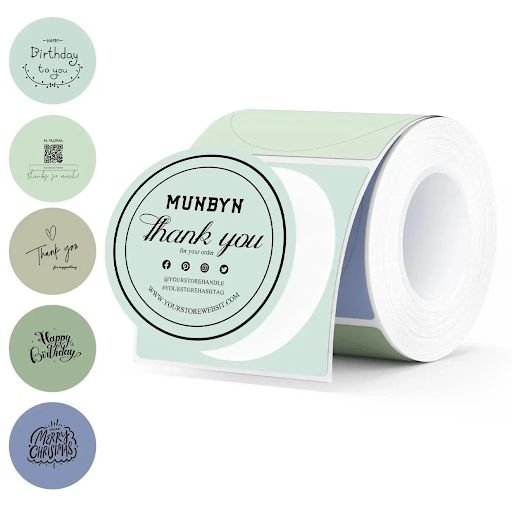In today’s fast-paced business environment, efficiency is key. Whether managing inventory, shipping products, or organizing files, labels play a crucial role in maintaining order and ensuring smooth operations. One of the most effective and widely used labeling solutions is MUNBYN thermal labels. These labels offer versatility, durability, and cost-effectiveness, making them an essential tool across various industries. Among the different types available, clear thermal labels provide an added advantage with their sleek and professional appearance.
 Understanding Thermal Labels
Understanding Thermal Labels
Thermal labels are specialized labels designed for use with thermal printers, which employ heat rather than ink or toner to produce images and text. These labels are categorized into two main types:
- Direct Thermal Labels: These labels feature a heat-sensitive coating that darkens when exposed to the thermal printhead. They do not require ink or ribbons, making them a cost-effective option for short-term applications like shipping labels, barcodes, and receipts.
- Thermal Transfer Labels: These require a ribbon to transfer ink onto the label, producing more durable prints that can withstand heat, moisture, and abrasion. They are ideal for product labeling, asset tagging, and industrial applications.
Why Businesses Rely on Thermal Labels
Thermal labels are an essential part of daily operations in various industries due to their efficiency and reliability. Here’s why businesses continue to choose them:
1. Cost-Effectiveness
Thermal labels eliminate the need for ink and toner, reducing long-term printing costs. Direct thermal labels, in particular, are highly economical for businesses with high-volume printing needs.
2. Speed and Efficiency
Thermal printers work quickly, allowing businesses to produce high-quality labels in a matter of seconds. This is crucial in logistics, warehousing, and retail settings where fast-paced operations demand quick turnaround times.
3. Durability and Readability
Thermal labels produce sharp, high-contrast prints that are easy to scan and read. When using thermal transfer labels, businesses benefit from long-lasting prints that remain legible even in challenging environments.
4. Versatile Applications
Thermal labels are used across various industries for multiple purposes, including:
- Retail: Price tags, barcode labels, and product tags.
- Logistics & Shipping: Address labels, tracking labels, and return stickers.
- Healthcare: Patient identification wristbands, specimen labels, and prescription labels.
- Food & Beverage: Expiry date labels, ingredient labels, and food packaging.
- Manufacturing: Equipment tagging, inventory labels, and compliance labeling.
The Benefits of Clear Thermal Labels
 While standard thermal labels provide efficiency and functionality, clear thermal labels offer additional advantages. These labels have a transparent finish, making them ideal for applications where a seamless and professional look is required.
While standard thermal labels provide efficiency and functionality, clear thermal labels offer additional advantages. These labels have a transparent finish, making them ideal for applications where a seamless and professional look is required.
1. Enhancing Product Packaging
Clear thermal labels allow for branding and essential product details without obstructing packaging designs. This is particularly beneficial for cosmetic, food, and beverage industries, where packaging aesthetics influence consumer perception.
2. Minimalistic and Professional Appearance
Businesses that prefer a clean, modern look often opt for clear labels. They blend seamlessly with surfaces, making printed text and barcodes appear as though they are directly printed onto the product.
3. Improved Durability
Clear thermal labels are resistant to moisture, oils, and harsh environments. This makes them suitable for industries that require labels to remain intact under demanding conditions, such as manufacturing and healthcare.
4. Multipurpose Use
From warehouse inventory to branding solutions, clear thermal labels can be used in various settings, offering both functional and aesthetic benefits.
Choosing the Right Thermal Labels for Your Business
Selecting the right type of thermal label depends on the specific needs of your business. Here are some key factors to consider:
1. Label Longevity
For short-term use, such as shipping labels, direct thermal labels are the best choice. If durability is needed, thermal transfer labels are a better option as they resist fading and environmental damage.
2. Print Quality Requirements
Businesses requiring crisp and long-lasting prints should opt for thermal transfer labels. If the goal is to maintain a minimalistic, professional look, clear thermal labels provide a great solution.
3. Surface Compatibility
Consider the surface where the label will be applied. Clear thermal labels work well on glass, plastic, and metal surfaces, offering a transparent and elegant finish.
4. Environmental Factors
For labels exposed to heat, chemicals, or outdoor conditions, thermal transfer labels provide superior durability. Clear thermal labels can also withstand moisture and friction, making them suitable for various industries.
The Future of Thermal Labels
As businesses seek more sustainable and innovative solutions, the thermal labeling industry is evolving to meet these needs. Developments such as eco-friendly label materials, recyclable thermal transfer ribbons, and RFID-enabled labels are paving the way for enhanced efficiency and reduced environmental impact. Clear thermal labels are also gaining popularity as businesses prioritize product presentation alongside functionality.
Conclusion
Thermal labels, including clear thermal labels, are essential tools for businesses looking to enhance efficiency, reduce costs, and maintain professional branding. Their versatility across industries—from logistics to healthcare—makes them a go-to solution for modern labeling needs. Whether used for barcoding, shipping, or aesthetic packaging, choosing the right thermal label ensures smooth operations and long-term benefits. As businesses continue to innovate, thermal labels will remain a crucial component in the world of product identification and inventory management.






